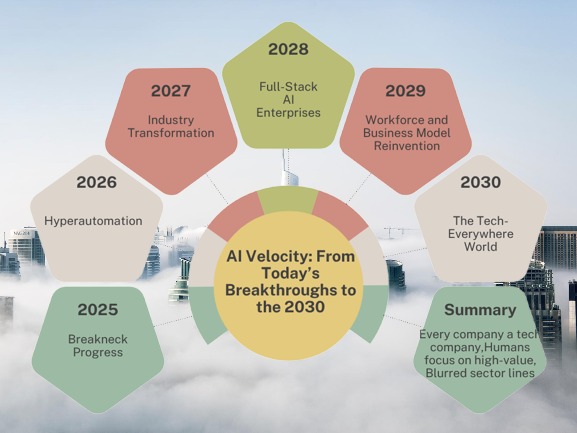AI Velocity: From Today’s Breakthroughs to the 2030 Tech-Everywhere Future—And How to Prepare
Explores the accelerating velocity of AI transformation from 2025 to 2030, charting how businesses and society will evolve as artificial intelligence becomes central to every industry. It examines the current breakthroughs, predicts future trends, and highlights the growing divide between AI adoption and risk awareness. The article offers actionable guidance for professionals, emphasizing lifelong learning, ethical responsibility, and adaptability to prepare for the tech-driven world of 2030.
ARTIFICAL INTELLIGENCE
Roland.R
11/10/20253 min read


Few technological advances have progressed as rapidly—or as disruptively—as Artificial Intelligence in recent years. As we stand in 2025, the velocity of AI is reshaping the very foundation of business and society. The coming five years promise even faster growth, global integration, and challenges at a scale we’ve never seen. What will 2030 look like—and how can today’s professionals and leaders prepare for a world where every company acts as a tech company?
Current Status (2025): Breakneck Progress
Unprecedented Acceleration:
2025 marks an era where AI models, such as GPT-5 and autonomous agentic systems, are making seismic leaps in intelligence and utility. AI now demonstrates PhD-level reasoning, near-perfect coding, and the capability to build end-to-end solutions from simple prompts.Industry Integration:
Not just reserved for Big Tech, AI is democratized and increasingly accessible. It automates routine tasks (customer service, financial analysis, contract management), manages business operations, and even supports strategic recommendations.Investment and Scale:
Since 2022, investment in generative AI has multiplied nearly eightfold. Multi-agent systems, exponential scaling of models, and drastic error reduction signal AI’s move from pilot to business essential.Autonomy and Platform Thinking:
Autonomous agents are now “staff” in many organizations, blending seamlessly into workflows and data processes.
2025–2030: AI’s Exponential Trajectory
2026–2027: Hyperautomation & Industry Transformation
AI begins to manage complete workflows—supply chains, HR, finance—without human intervention. AI copilots become standard, pushing new highs in productivity and competitive differentiation. Companies not leveraging AI face sharp declines in efficiency.2028: Full-Stack AI Enterprises
The boundary between “tech” and “non-tech” companies vanishes. AI-powered platforms dominate everything from logistics and healthcare to manufacturing and retail. Businesses rebrand around real-time insight, analytics, and digital customer value.2029: Workforce and Business Model Reinvention
Routine roles are widely automated; teams focus on creativity, complex problem-solving, and launching new digital business streams. Continuous AI governance, learning, and compliance are standard.2030: The Tech-Everywhere World
By 2030, 70–86% of global enterprises are AI-native or “AI-first.” Data and digital infrastructure drive market leadership. For others, survival becomes nearly impossible without embracing tech DNA. Innovation happens at a pace never seen before: businesses pivot, scale, and reinvent overnight, powered by platforms and intelligent systems.
Where We Will Be by 2030
Every company a tech company: AI, automation, and platform ecosystems are as essential as electricity.
Humans focus on high-value: Repetitive and analytical tasks handled by AI; people drive creativity, empathy, and complex strategy.
Blurred sector lines: AI makes industry boundaries fade; success relies on digital adaptability.
Continuous transformation: The competitive edge lies in learning, reskilling, and AI governance—not just launching the latest tool.
Takeaway: How to Prepare for 2030—Actions for Professionals
(Backed by deep research and current forecasts)
Embrace Lifelong Learning and Upskilling:
Tech and AI skills will be required for 70% of jobs by 2030.
Invest in technical upskilling (AI literacy, data fluency) and creativity, complex problem-solving, and adaptability.
Seek training in both digital tools and human skills; fields like resilience, communication, and leadership grow more valuable as AI expands its technical footprint.
Develop AI Literacy and Strategic Thinking:
Even non-technical professionals need to understand AI’s potentials and limits.
Foster the ability to identify AI opportunities within your function; learn to work alongside intelligent systems.
Prioritize Data Ethics, Security, and Responsible Innovation:
Get familiar with data privacy, bias mitigation, and ethical AI frameworks.
Champion responsible AI use in your organization and industry.
Cultivate Agility and Adaptability:
The most successful professionals will rapidly pivot and adapt to new technologies and models.
Stay curious and open to new roles as automation changes traditional career paths.
Focus on Collaboration and Interpersonal Skills:
AI cannot fully replicate human creativity, critical thinking, and empathy.
Build relationships, work effectively in teams, and lead diverse, interdisciplinary initiatives.
Engage in Continuous Innovation:
Champion experimentation in your team or business.
Embrace rapid learning, frequent pilots, and scalable digital solutions.
In Summary:
The next five years will reward those who blend tech fluency and human ingenuity. For individuals, teams, and organizations, the imperative is clear: Proactively invest in learning, adaptability, and ethical, strategic use of AI. By 2030, these will be the foundations not just for success, but for survival in an AI-powered, tech-driven world.
Connect
Get in touch for collaboration opportunities.
© 2025. All rights reserved.


